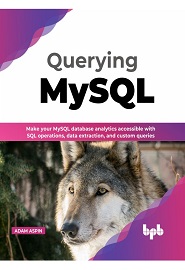
English | 2022 | ISBN: 978-9355512673 | 672 Pages | EPUB | 10 MB
Carry out real-world analytics to advance your career
Key Features
- Learning the principles of data analysis with MySQL datasets in a practical manner.
- Extensive examples guide the reader through all stages of SQL proficiency, from complete newbie to master.
- Includes methods and methodologies for doing sophisticated MySQL database queries.
This book will take you on an interactive journey to understand SQL querying from the most basic to the most expert level utilising a variety of SQL techniques to extract relevant insights from your MySQL databases.
The first section of this book serves as an introduction to the fundamental ideas of both SQL and MySQL. It then walks readers through constructing queries using simple and then more sophisticated table joins and gradually more advanced data filtering to produce advanced queries based on a range of SQL techniques. The reader will better understand MySQL database analysis by mastering the fundamentals of SQL computation, relational logic, and data grouping and aggregation. SQL fundamentals such as query formatting, constructing subqueries, generating derived tables, joining and filtering tables, etc., are also covered. In addition, the book explains how to do rolling analysis, study time-series data, and manage huge and complex MySQL datasets.
After completing the book, readers can create their methods for analysing relational MySQL datasets and gaining the needed insights.
What you will learn
- Review SQL concepts like table join, data filtering, query structuring, and table derivation.
- Make it easier to work with data that is spread out over several tables with similar or identical structures.
- Use simple math and logic, multiple filters, and data aggregation to look at the data.
- Learn how to use table expressions, subqueries, and complex calculations well.
- Use advanced methods to do rolling analysis and time series analysis.
Resolve the captcha to access the links!